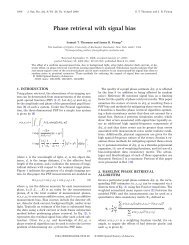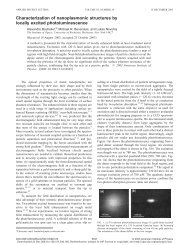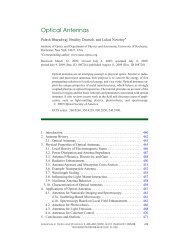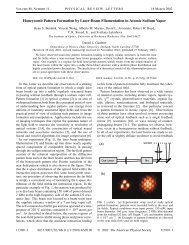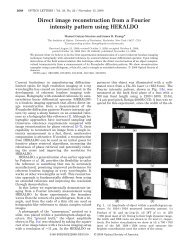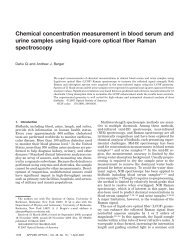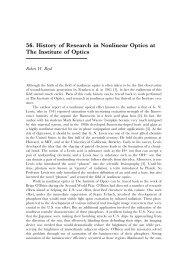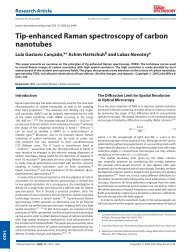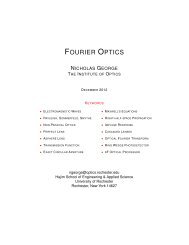Nonlinear Excitation of Surface Plasmon Polaritons by Four-Wave ...
Nonlinear Excitation of Surface Plasmon Polaritons by Four-Wave ...
Nonlinear Excitation of Surface Plasmon Polaritons by Four-Wave ...
Create successful ePaper yourself
Turn your PDF publications into a flip-book with our unique Google optimized e-Paper software.
PRL 101, 056802 (2008)<br />
PHYSICAL REVIEW LETTERS week ending<br />
1 AUGUST 2008<br />
I p / I s<br />
(a)<br />
(b)<br />
2.5<br />
(c)<br />
2.0<br />
1.5<br />
1.0<br />
0.5<br />
0<br />
0<br />
10 20 30 40 50<br />
θ(deg)<br />
60<br />
plasmon dip at the Kretschmann angle indicates that the<br />
dominating nonlinear contribution is a third-order surface<br />
susceptibility. As in the case <strong>of</strong> SHG [cf. Fig. 2(a)], this dip<br />
originates from a nonlinear surface polarization P # x ! 4wm<br />
at the lower gold interface. P # x gives rise to radiation at<br />
frequency ! 4wm emitted into both the lower half-space<br />
(glass substrate) and the metal film. The latter excites<br />
surface plasmons at the upper gold interface, and the<br />
resulting leakage radiation interferes destructively with<br />
the radiation emitted directly into the lower half-space.<br />
This interference is phase-sensitive, and the appearance<br />
<strong>of</strong> a dip requires a clear phase separation between the<br />
two interfering components. No dip would be expected if<br />
the third-order nonlinearity were entirely associated with a<br />
bulk response. We hence conclude that surface plasmon<br />
excitation <strong>by</strong> four-wave mixing is dominated <strong>by</strong> a thirdorder<br />
surface nonlinearity.<br />
We thank Giovanni Piredda for stimulating discussions.<br />
This work was supported <strong>by</strong> the U.S. Department <strong>of</strong><br />
Energy under Grant No. DE-FG02-01ER15204.<br />
FIG. 4 (color online). <strong>Nonlinear</strong> four-wave mixing at a 52 nm<br />
gold film on a glass substrate. (a),(b) CCD images using expanded<br />
excitation beams. (a) p-polarized excitation beams;<br />
(b) s-polarized excitation beams. (c) Angular dependence <strong>of</strong><br />
four-wave mixing radiation ( 4wm 613 nm). The curve shows<br />
the ratio <strong>of</strong> four-wave mixing intensity generated <strong>by</strong> p-polarized<br />
excitation (I p ) and four-wave mixing intensity generated <strong>by</strong><br />
s-polarized excitation (I s ).<br />
which suggests that both bulk and surface nonlinearities<br />
are involved in the four-wave mixing mechanism.<br />
Figure 4(c) plots the normalized 4WM signal over the<br />
entire range <strong>of</strong> incident angles . The graph represents<br />
the ratio <strong>of</strong> four-wave mixing intensity generated <strong>by</strong><br />
p-polarized excitation (I p ) and four-wave mixing intensity<br />
generated <strong>by</strong> s-polarized excitation (I s ). The normalization<br />
is performed in order to remove any possible artifacts due<br />
to diffraction at the rims <strong>of</strong> the backaperture and due to<br />
spectral and angular variations <strong>of</strong> the objective’s transmissivity.<br />
Interestingly, the emitted 4WM radiation is predominantly<br />
p-polarized even if the incident waves are<br />
s-polarized. Additionally, for p-polarized excitation, the<br />
total emitted intensity at ! 4wm is approximately twice as<br />
strong as the intensity generated <strong>by</strong> s-polarized excitation.<br />
These observations indicate that the third-order surface<br />
polarization is a dominant contribution in nonlinear fourwave<br />
mixing at metal films.<br />
In conclusion, we used nonlinear four-wave mixing to<br />
excite surface plasmons on a gold film. A characteristic<br />
*http://www.nano-optics.org<br />
[1] <strong>Surface</strong> <strong>Plasmon</strong> Nanophotonics, edited <strong>by</strong> M. L.<br />
Brongersma and P. G. Kik (Springer, Dordrecht, 2007).<br />
[2] S. A. Maier, <strong>Plasmon</strong>ics: Fundamentals and Applications<br />
(Springer, New York, 2007).<br />
[3] E. Ozbay, Science 311, 189 (2006).<br />
[4] A. Sommerfield, Ann. Phys. Chemie 67, 233 (1899).<br />
[5] J. Zenneck, Ann. Phys. 23, 846 (1907).<br />
[6] E. Devaux, T. W. Ebbesen, J. C. Weeber, and A. Dereux,<br />
Appl. Phys. Lett. 83, 4936 (2003).<br />
[7] B. Hecht et al. Phys. Rev. Lett. 77, 1889 (1996).<br />
[8] E. Kretschmann and H. Raether, Z. Naturforsch. A 23,<br />
2135 (1968).<br />
[9] A. Otto, Z. Phys. 216, 398 (1968).<br />
[10] Y. R. Shen, The Principles <strong>of</strong> <strong>Nonlinear</strong> Optics (Wiley,<br />
New York, 1984).<br />
[11] H. J. Simon, D. E. Mitchell, and J. G. Watson, Phys. Rev.<br />
Lett. 33, 1531 (1974).<br />
[12] H. J. Simon, R. E. Benner, and J. G. Rako, Opt. Commun.<br />
23, 245 (1977).<br />
[13] Y. R. Shen, Nature (London) 337, 519 (1989).<br />
[14] A. Bouhelier et al., Opt. Lett. 32, 2535 (2007).<br />
[15] P. Guyot-Sionnest and Y. R. Shen, Phys. Rev. B 38, 7985<br />
(1988).<br />
[16] M. Born and E. Wolf, Principles <strong>of</strong> Optics (Cambridge<br />
University Press, Cambridge, 1980).<br />
[17] The fields can be derived using the Green’s function in the<br />
form I $ k r 2 rr G o r; r 0 and expressing the scalar<br />
Green’s function G o in terms <strong>of</strong> the Weyl identity.<br />
[18] A. Bouhelier and G. P. Wiederrecht, Opt. Lett. 30, 884<br />
(2005).<br />
056802-4



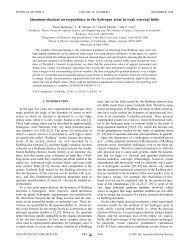
![Phase retrieval algorithms: a personal tour [Invited] - The Institute of ...](https://img.yumpu.com/25023725/1/190x249/phase-retrieval-algorithms-a-personal-tour-invited-the-institute-of-.jpg?quality=85)
